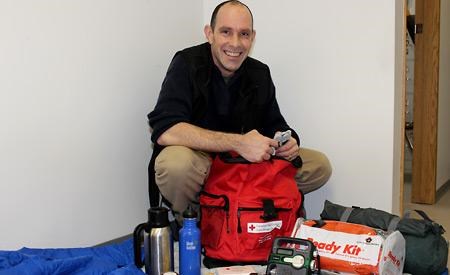With a full-time coordinator on the job, the Powell River Regional Emergency Program (PRREP) is poised to roll out services to the entire region.
PRREP includes the City of Powell River as a participant in the Powell River Regional District’s (PRRD) emergency preparedness bylaw. PRREP officially started on January 1 and Ryan Thoms was hired on February 15 as the emergency program coordinator. “Regionalization is nothing that we’ve invented here,” said Thoms. “It’s actually becoming increasingly common, for obvious reasons.”
Talks to combine regional district and city emergency programs began last year. Thoms said the model officials liked the best was a regional district model that would deliver the service on behalf of everybody within the regional district boundaries, including residents of the city.
The PRRD stretches from Desolation Sound to Jervis Inlet and encompasses Texada, Savary, Hernando and Lasqueti islands. “It gives us a nice, seamless platform on which to start doing our emergency planning, preparedness, response, recovery and working with the agencies that do respond within there,” Thoms explained.
Thoms worked with the BC Wildfire Management Branch for 15 years, then was the coordinator of the regional district’s rural emergency program for four years. He is a full-time employee of the regional district and his office is in the regional district’s office in Townsite.
PRREP has a number of benefits, Thoms said, referring to the well-known comment that disasters know no boundaries. “We live in a very small region by global standards. Our population base is about 20,000, with a small municipality, small first nation and small rural area, although somewhat expansive. Disasters will not respect that.”
The most significant disaster knowing no boundaries was the Japanese earthquake and tsunami, which struck a year ago on March 11. Approximately 20,000 people died or are missing. The tremors triggered multiple meltdowns at the Fukushima power plant in Okuma, unleashing the world’s worst nuclear crisis in 25 years. Efforts to rebuild have been slow and some 325,000 people remain in temporary housing.
“For us living on the Ring of Fire, those are the kinds of things that we know someday will happen here,” Thoms said. “Hopefully not for many, many years but we know that they do happen and that’s where we need to be prepared ahead of time for this kind of event.”
Regionalization means emergency plans will be able to focus on areas without being restricted to city-regional district boundaries. For example, plans can be made for north and south of the bridge crossing Powell River, in the event of a disaster that took out the structure. “We can now look at logistical and geographic issues instead of just looking at our local government boundaries,” Thoms said. “We can start to make emergency planning that will share resources.”
Another benefit of PRREP is being able to draw on a larger resource pool to staff an emergency operations centre (EOC). “The idea of doing EOC on a 24/7 basis for any number of days is pretty challenging for most small communities,” Thoms said. “The idea to train our staff together and start practicing and the idea of running an EOC and sharing staff is something that I think will be a benefit for us.”
The legal authority for PRREP comes from the BC Emergency Program Act. Its mandate includes emergency response exercises and training programs. As well, it must establish procedures to notify residents who may be harmed or suffer loss by an emergency or impending disaster, coordinate the provision of food, clothing, shelter, transportation and medical services to victims of emergencies and disasters and establish the priorities for restoring essential services provided by local authorities.
Thoms said it takes everyone working together to meet that mandate, including responders, volunteers in emergency programs, local governments and the public being prepared.
A website is expected to be up and running by early May. Interested readers can follow PRREP on Twitter at @EmergencyPRREP.



